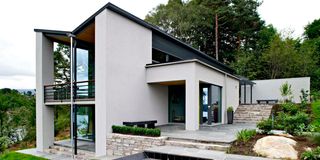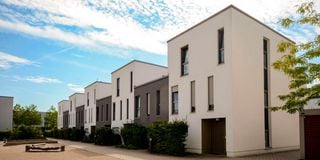Ready to pay the steep price: Why more Kenyans are going for luxury developments

Savvy developers keen on capitalising on this increasing demand have incorporated world-class luxury amenities such as luxury spas, indoor water parks, dedicated lounges and casinos, among other state-of-the-art facilities into their developments, luring buyers by providing everything they could possibly want.
Due to relatively high urbanisation and population growth rates, many are moving away from the city to live in satellite towns that offer a chance to become one with nature.
Additionally, land in these satellite towns is affordable, with ongoing improvements to infrastructure and essential amenities such as schools and hospitals making them more accessible and desirable to live in.
Meanwhile, savvy developers keen on capitalising on this increasing demand have incorporated world-class luxury amenities such as luxury spas, indoor water parks, dedicated lounges and casinos, among other state-of-the-art facilities into their developments, luring buyers by providing everything they could possibly want.
As a result, a new class of ‘lifestyle developments’ has become very prominent in various parts of the country. In Thika, for instance, the Thika Greens Golf Resort, comprising villas that sit on a 1,700-acre estate, has been selling buyers its scenery, elegance and serenity, while areas such as Vipingo and Kilifi have been developing villas and modern maisonettes in gated communities close to coastal beaches.
Small towns such as Mbita in Homa Bay County are also host to a number of luxury villas, as more people seek alternative holiday destinations from Mombasa, which becomes flooded during the festivities, and Kisumu, which according to revellers has become dormant.
Athi River has also been seeing lots of lifestyle development activity, with real estate firms leveraging the allure of proximity to the Nairobi National Park to attract customers.
Notable projects
Notable projects in the township include Athi River Green Park Estate, a community project comprising 500 sold units, the Crystal Rivers Mall project, Gateway Garden, Lukenya Wildlife conservancy Living Development project that is located within Swara Plains Conservancy in Athi River, among others.
While the exclusivity and luxury accompanying these developments have made them generally more expensive than conventional ones, Stephen Lutta, an architect with the architectural and interior design firm, Bomani, says these developments, interestingly, seem to be selling much faster than conventional developments.
He explains that people are willing to pay a premium rate for such developments because unlike in a town setting where most services are generally unplanned even though one can easily access most of the necessary amenities, in such lifestyle developments, everything is very well planned and in good working order.
“Given an opportunity, many people would move away from the city due to poor planning,” says Lutta, observing that most apartments are so cramped, that you do not have somewhere you and your children can relax, or the apartment is in the vicinity of a noisy bar, or the drainage does not work. He adds that due to the rising levels of insecurity in the city, people are also retreating to gated communities in the suburbs where they feel safer.
He observes that many developers have invested heavily in such developments to include amenities such as schools, churches, hospitals, clubhouses and police stations in these upmarket, gated communities, offering well-organised living coupled with conveniences that you would only find out of town.

Stephen Lutta is an architect with architectural and interior design firm Bomani.
“This is exactly what is happening in places like the Oaklands in Ruiru, Northlands, Konza City or even Nanyuki. Real estate dealers have realised that if they had a piece of land and subdivided it into 50 by 100 plots then try to sell them, versus building a gated development on the entire piece of land with necessary amenities, even if it is more expensive, the gated community would sell faster than the sub-divided land,” notes Lutta.
Even a simple step such as installing cabro blocks can lure buyers to some of these developments, as someone would not, especially on a rainy day, want to leave the tarmac only to join a dirt road where they will get stuck as they drive home.
Quick return on investment
Robert Otieno, an architect, says that for developers and investors, injecting extra capital into these developments is not a problem, because while the initial cost of construction might be high, they are assured of a quick return on investment. Whether rented out on a monthly basis, or on a daily basis, the rental yields for these lifestyle developments far exceed those obtained from conventional rental developments.
“Owners are also able to draw an extra income from other businesses established within these developments for the convenience of tenants, such as spas, shopping malls and lounges,” notes Otieno.
These developments mostly lure buyers for their scenery and serenity, factors that can make modern life more bearable - studies have revealed that people who live in greener areas, with more vegetation and other aspects of nature around, have a lower risk of mortality. The health benefits include improved mental health, more social engagement and physical activity motivated by living near green spaces.

Due to relatively high urbanisation and population growth rates, many are moving away from the city to live in satellite towns that offer a chance to become one with nature.
For this reason, Otieno observes that in some cases, developers have gone the extra mile to adopt architectural guidelines that ensure their building practices do not interfere with but blend with nature.
“We are seeing architects come up with homogenous structural designs, hence eco-villas that touch the earth lightly or that are built in tandem with nature. This is only fitting because these developments lure people for the opportunity that they provide to become one with nature or at the very least to have peace of mind,” observes Otieno.
Chacha Collins, a realtor, notes that the uptake of these developments has been especially high amongst Kenyans who have lived in the diaspora, and who have experienced what it is like living in a place where there is peace and order, though the expectation is that many more locals will go for such product listings, simply for the value for money they provide.
He also notes that people looking for private holiday destinations, as well as those attending conferences in remote townships and wanting to be comfortable, will also drive-up demand for such developments. Similarly, expatriates moving to work for international organisations that are setting up bases in Kenya are also expected to drive up demand.
“Besides the privacy and the comfort that they offer, for a visitor, these developments are also cheaper to live in than a hotel. For instance, a hotel may charge Sh40, 000 per night for one person, yet a three-bedroom apartment would go for Sh50,000 per night and can accommodate a family or a group of up to five people,” notes Chacha.
Indeed, this has seen many hotel owners, especially in the coastal parts of the country, incorporate lifestyle developments into their establishments, with some even replacing the hotel with such developments. The market has become so lucrative that industry stakeholders are no longer selling apartments, but are instead targeting clients with lifestyle developments.
“For instance, I am selling five-bedroom developments in Thika Greens near the golf course and just recently, in the same vicinity, there is a developer who has put on the market eight fully furnished four-bedroom developments. This already has made land in Thika Greens, Mombasa and other areas like Kwale appreciate significantly, and in the next two to three years, going by the inquiries we are getting, it could go up by more than 100 per cent,” notes Chacha.
Resort settings
Looking into the future, he is of the opinion that we can expect to see more lifestyle properties come up near conservancies or resort settings as developers target upper and middle-income earners with luxury as the selling point.

Chacha Collins is a real estate marketing executive.
“A growing middle class, as well as a burgeoning economy, will continue to drive growth in this sector. And because the yields are also high, ranging from between 6-12 per cent is that this is a high-end market, we can expect to see investors and developers also going big on this sub-sector,” notes Chacha.
An increasing number of visitor arrivals into the country brought about by a stable social, political and economic environment, is also expected to continue boosting the performance of lifestyle developments especially at the Coast and in townships near international airports.
Kenya’s tourist arrivals surged by 91 per cent in the first eight months of the year 2022 to 924,812 international visitors from 483,240 arrivals recorded in the same period in 2021. Meanwhile, international arrivals through Jomo Kenyatta International Airport and Moi International Airport increased by 44.6 per cent to 315,112 in the third quarter of 2022, from 217,873 recorded in the third quarter of 2021.
Presence of key infrastructure developments that have either been completed or that are under construction, such as the Nairobi Expressway, the Kenol-Marua-Isiolo Road, Lamu-Garissa-Isiolo Road, Dongo Kundu Bypass, Mai Mahiu Suswa Road which serves the Maasai Mara Game Reserve, several international airports, among other infrastructure projects that lead to prime nature destinations, are also expected to attract more high-net-worth potential buyers and investors to the sector.
Isiolo attraction
Some of the places where we can expect to see a lot of lifestyle development activity going on, notes Lutta of Bomani, include Isiolo. In terms of geography, Isiolo is right at the centre of Kenya, and the equator passes there, so of its strategic location, the town is soon expected to achieve the status of a city. Isiolo is also on the Lapsset corridor. The Lapsset corridor comprises seven key infrastructure projects expected to significantly boost trade between Kenya, South Sudan and Ethiopia.
“Thanks to Lapsset, Isiolo will have a rail and road network connecting it to Lamu, to Juba in South Sudan, and Addis Ababa in Ethiopia. Isiolo also has an international airport. These factors are already seeing more people move here, and we can expect to see more developments coming up to serve these people,” notes Lutta.
In the coastal parts of Kenya, we can expect to see more developments coming up in Malindi moving towards Lamu, and Kilifi for the beaches and increased economic activities in these areas. In Mombasa too, once the Dongo Kundu bypass that connects Mombasa mainland West with Mombasa mainland South, without passing through Mombasa Island is completed, we can expect to see a ripe environment for more lifestyle developments, as there will be a lot of industrial activity in the Dongo Kundu-Likoni area that will attract many people, including expatriates.
Being emerging cities, Nakuru and Eldoret too are ripe for development. Kisumu too has seen some resuscitation with new road and rail networks being developed there, therefore creating a conducive environment for lifestyle developments.
Fast-growing towns such as Mbita in Homa Bay are also expected to drive up demand for lifestyle developments in that part of the country. For their proximity to Nairobi and closeness to nature, Muranga and Athi River remain prime locations for lifestyle developments.





